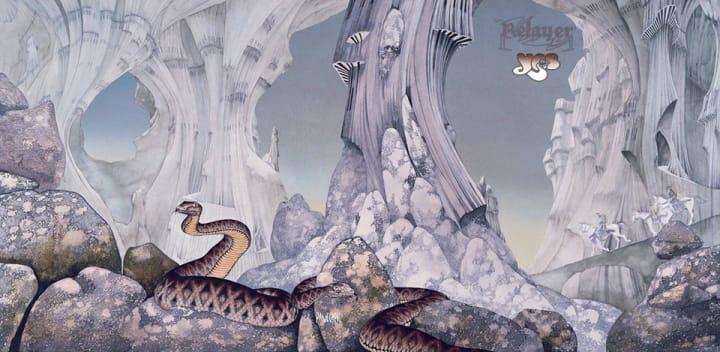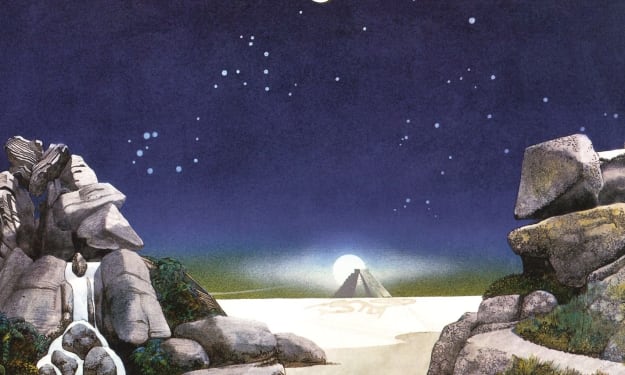'Relayer' - A True Fruition
Another Layer of Yes Music!

Tales from Topographic Oceans was an album that was the pinnacle of Yes music in the eyes of some, and an example of over-indulgence in the eyes of others. After the tour, Rick Wakeman left the band, and Yes were in need of another keyboardist. They ended up with former Refugee member Patrick Moraz, who added his own unique flavor to the album that became Relayer. Released November 28, 1974, Relayer was the seventh album released by Yes within a span of a little more than five years, which is an impressive feat. Indeed, any band with that much output within so small of a span should feel proud to have an album like Relayer at the end of that span.
"The Gates of Delirium"
Jon Anderson was influenced by the Leo Tolstoy novel War and Peace when it came to "The Gates of Delirium." Patrick Moraz has also claimed that the title may have stemmed from when he showed Anderson a copy of sci-fi comic Delirius by Philippe Druillet. The title of the track is certainly a memorable one, and the music does give off a vibe that depicts delirium.
Once the song begins, it feels like we are dropped into the song in media res, with music that feels like it started playing before we started listening, if that makes sense. It has a feeling akin to that of being dropped into the middle of a march toward a battle. Patrick Moraz seems to announce that the battle is about to start. Alan White's drumming brings a war-like quality to the track. Each "la la" that is sung might bring "Ritual" from the previous album to mind. To some, this might feel like a sequel to "Ritual" since it involves fighting.
Anderson announces the apparent start of a battle with a command: "Stand and fight we do consider / Reminded of an inner pact between us / That's seen as we go." Throughout the song, Howe and Squire provide great vocal harmonies. "As frictions spans the spirits' wrath ascending to redeem" is followed by a brief moment of hopeful music. But then we are reminded of "Wars that shout in screams of anguish." We are eventually brought to a moment of negotiation: "Listen, should we fight forever / Knowing as we do know fear destroys?" On 1993's Symphonic Music of Yes, Howe recites these words before "Soon," and it is a question worth asking in times of conflict.
Ultimately, the "fighting" in the song continues. The vocals and instrumentation during "The fist will run, grasp metal to gun" feels metal to me. The inclusion of that word probably reinforces the connection. After the stanza containing those words, we are taken into an instrumental war. Indeed, in war, there is no time for words, just action. The Yes members do a great job of painting the atmosphere with sound. Toward the end of the instrumental section, the music gets upbeat, as if depicting a sweep of victory, with Moraz's work possibly bringing lasers to mind. The splendid chaos of the music is another reason this song may feel like a successor to "Ritual."
And in fact, after the battles in both songs, the music calms down for a quieter section. Here, it is the pensive "Soon," the tone of which feels like a eulogy and mourning of the dead. Howe's pedal steel guitar contributes greatly to the somber feel. "Pass within and soothe this endless night" is sung like a desperate plea. The light is "Ours to shape for all time" and that "The sun will lead us / Our reason to be here." One may be reminded of "Nous somme du soleil" in "Ritual," which told us that we are of the sun. A studio run-through included on the 2003 Rhino reissue of the album has "Soon" followed by the music that preceded it, but "Soon" works better as the finale.
While "Soon" would be performed live by itself from time to time, "The Gates of Delirium" would not be played in full after 1976 until the 2000 Masterworks Tour. After that, it was performed on the 2001 Yessymphonic Tour, and then it was not played again live until the 2019 Royal Affair Tour that concluded last month.
A performance of "The Gates of Delirium" from Yes: Live – 1975 at Q.P.R.
2. "Sound Chaser"
"Sound Chaser" has fusion and jazz bits within it. Moraz plays very elegantly from the beginning. As the song continues, the music starts to sound like the tweeting of birds. The song gets faster and faster, making it fitting that the first words sung are "Faster moments spent spread tales of change within the sound." The track is very electric, hence the words "electric freedom." We get a variation of the album title within the line "Passing time will reach as nature relays to set the scene."
The music continues to get intense after the line, "As we accelerate our days to the look in your eyes." Squire's bass line is very impressive, and we get another strong and dramatic guitar solo from Howe. Once the moodiness of the guitar subsides, Anderson sings gently. The verse "And to know that tempo will continue lost in trance of dances" is very telling of what is to come. After this stanza, the sounds of the instruments seem to dance together, with "CHA-CHA-CHA CHA-CHA" being sung in between. Rhythm twists and turns indeed at a rapid speed, bringing "Sound Chaser" to a memorable finish.
3. "To Be Over"
"To Be Over" begins with a contemplative instrumental section, drifting through thought. And among the first lyrics are "Drifting endlessly by the bridge / To be over." This song advises listeners that they should not remain in states of pain: "Do not suffer through the game of chance that plays." After "Balance the thoughts that release within you is sung," we are treated to upbeat notes. This may represent how one can become uplifted if they go through the effort of cleansing their minds of whatever evils may persist within them.
"Holding doors will open every way" seems to reassure us that there will be choices for us to make, and that there will always be something that will lead us somewhere, just as "Survival" on the first Yes album said "And we're all going somewhere." Under other circumstances, the words, "After all, your soul will still surrender" may sound sinister. But they are followed by "After all, don't doubt your part / Be ready to be loved." So this is more of a positive type of surrendering that involves putting one's fate in the hands of something higher that may guide one to their best possible path.
As the song gets ready to be over, there is chanting. Fans over the years thought the words of the chant included "nous sommes du soleil" or "somehow, someday." (The latter would actually become the title of a Yes song on Open Your Eyes in 1997). In June 1976, Jon Anderson was interviewed by Connor Freff Cochran for the sci-fi fanzine Khatru, where he explained that the chanting is comprised of words that are not meant to mean anything in particular. He also explained that the words were the following: "'New som du lay sah du rah sah du lay tu sah rah, du sah du lay, sah du rah, tey tu santeh.'" Even if these words do not have an exact meaning, they are fun to say. Knowing the exact wording, and being able to sing along to the chant is like being given the keys to paradise.
(Click this link and scroll down for an explanation of the chanting at the end of "To Be Over").

Conclusion
Structurally, one could compare Relayer to Close to the Edge. Side A contains an epic while side B contains a soft song and a rhythmic song. One might be able to argue that the tracking order on Relayer works better. While Close to the Edge feels as though the tracks should be in reverse, progressing toward the stronger song, the tracking order of Relayer feels natural, with "To Be Over" feeling like the logical conclusion to it all despite being the most gentle song. In any case, they are both fantastic albums, and Relayer would be remembered as another incredible effort put out by Yes.
Producer Eddy Offord would take a break from the band before returning to co-produce Drama in 1980, and Patrick Moraz would be let go from the band during the Going for the One sessions before Rick Wakeman's return. Moraz has since expressed his gratitude for being involved with Yes. According to Chris Welch's book Close to the Edge: The Story of YES, Moraz offered up his services in 1997 when they were in need of a keyboardist again. In 2017, he watched the induction of Yes into the Rock & Roll Hall of Fame, and in 2018 he was one of various Yes guests at YesFanFest in Philadelphia, where he performed "Soon" with the band (which can be heard on Yes: 50 Live). Every now and then, there are rumors that the entire Relayer album may be performed in full again, with Patrick Moraz guesting. If such a thing were to happen, it would be a dream come true.
About the Creator
Steven Shinder
Author of fantasy horror comedy novel Lemons Loom Like Rain, which is available on Amazon. You can also read excerpts at stevenshinder.com and check out facebook.com/StevenShinderStorytelling.






Comments
There are no comments for this story
Be the first to respond and start the conversation.